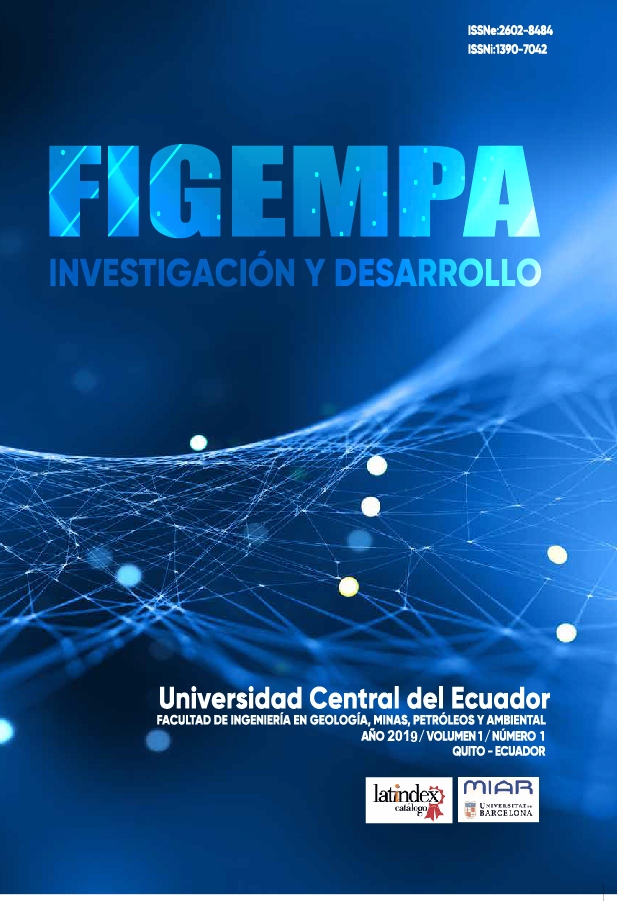Buckley Leverett theory application in improved recovery by solvent injection in the VHR Field.
Main Article Content
Abstract
This study presents the laboratory results of the solvent injection in samples obtained from reservoir M-2, the VHR oil field of the Ecuadorian Amazon region. The objective was to determine the increase of the recovery factor in cores saturated with oil of 29.2 API degree. This study consisted of three stages: in the first stage, several EOR methods that can potentially be applied to cores, which was obtained from the M-2 sandstone, that ones were analyzed. In the second stage, an oil displacement was made using formation water, this result was used as a reference point. In the third stage, the oil was displaced with solvent and compared with the result of the second stage. For the second and third stages, a simple model based on the Buckley-Leverett theory was developed. This model helped to quantify the increase in the recovery factor. The screening criteria determined that the conditions were appropriate for solvent injection. The reference point gave a recovery factor of 25.7 percent. On the other hand, the displaced oil after using solvent was 43.74 percent. This result means an increase of 18.04% in the recovery factor. The numerical method gave a recovery factor of 49.97 percent, which is 6.23 percent higher than the experimental values. The experiment allowed to conclude that the option of injecting solvent is very practical for use in a pilot project for the M-2 reservoir of the VHR field of the Ecuadorian Amazon region.
Downloads
Metrics
Article Details

This work is licensed under a Creative Commons Attribution 4.0 International License.
References
Bolaños, J. (2016). Desarrollo de Software para la selección de Métodos de Recuperación Mejorada de Petróleo. Universidad Central del Ecuador. Quito, Ecuador.
Cárdenas, K. (2018). Determinación del comportamiento de la presión de los reservorios del campo Víctor Hugo Ruales mediante análisis de pruebas de restauración de presión para desarrollar propuestas de optimización de producción. [Tesis de grado]. Universidad Central del Ecuador. Quito, Ecuador.
Criollo, S. (2011). Water and surfactant Flooding at Different Wettability Conditions. [Tesis de Posgrado]. University of Stavanger, Noruega.
Dynadrill, S.A. (2019). MSDS. Quito, Ecuador.
Herrera, L. (2013). Estudio de alternativas de recuperación mejorada para la incorporación de nuevas reservas y aumento de la Producción en la Formación Napo “T” Inferior del Campo Tiguino. [Tesis de grado]. Universidad Central del Ecuador. Quito, Ecuador.
Petroamazonas EP & IGAPÓ S.A. (2017). Plan de desarrollo del campo Víctor Hugo Ruales, Quito, Ecuador.
Petroamazonas EP. (2019). Manual de Laboratorio CIQ, Quito, Ecuador.
Petroamazonas, EP & IGAPÓ S.A. (2018). Plan de desarrollo del campo Víctor Hugo Ruales, Quito, Ecuador.
Petroamazonas, EP & IGAPÓ S.A. (2019). Plan de desarrollo del campo Víctor Hugo Ruales, Quito, Ecuador.
Salager, J. L. (2005). Cuaderno FIRP s357c, Recuperación Mejorada del Petróleo, Mérida Venezuela.
Stosur, G., Hite, J., Carnahan, N. and Miller, K. (2003). The alphabet soup of IOR, EOR and AOR: effective communication requires a definition of terms. [online] One Petro. Available at: https://doi.org/10.2118/84908-MS [Accessed 2 Mar. 2018].

